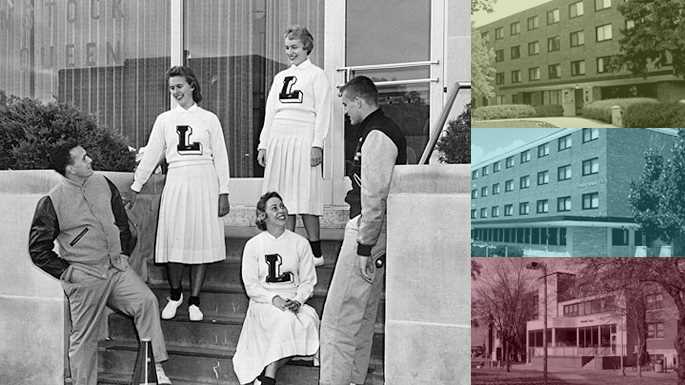Posted 1 p.m. Tuesday, Aug. 16, 2016

Baird, Trow and Wilder coming back.
Names heard on the campus for nearly the first century of its history will be heard again. The three campus residence halls torn down in summer 2009 — Baird, Trowbridge and Wilder — and the women for whom they were named won’t be forgotten. Their history is being remembered in Eagle Hall, which replaced the lost residence hall rooms. The former buildings and faculty are being honored in Eagle Hall community rooms with historical plaques that will be dedicated following an invitation-only breakfast at 9 a.m. Thursday, Sept. 1.

Betty Baird
Betty Baird followed her sister, Beatrice, to UWL in 1947 to teach physical education. Baird was called “one of the most outstanding women’s swimming and diving instructors La Crosse State ever had.” She advised the Catalina Club and Tumbling Club, and was a member of the La Crosse State College Foundation Board of Directors. Poor health forced her to retire in March 1963. She died July 18, 1963.

Baird Hall
Baird Hall opened in fall 1963 as the third campus residence hall for women. Following physical education Professor Betty Baird’s untimely death earlier in the year, the building was named for her “in recognition of her great courage in adversity.” Betty’s sister, Beatrice, taught in the physical education department from 1946-1974. When she died in February of 1989, discussion of adding her name to the building began. In December 1989, the UW Board of Regents renamed Betty Baird Hall “Betty and Beatrice Baird Hall” to recognize the contributions of the sisters as outstanding educators and mentors. In its second decade, Baird became coed, and serving predominately upperclassmen and international students. Baird Hall celebrated a farewell party on May 2, 2009. The hall was razed that summer to make room for Centennial Hall.

Myrtle Trowbridge
Myrtle Trowbridge, a history professor on campus from 1918-1954, had a special connection with students. More than 12 years of letters written to her from soldiers all over the world are archived in the Murphy Library’s Special Collections. Trowbridge traveled extensively and used observations to supplement her classes. She was instrumental in organizing faculty senates that are now on all UW campuses. She created “The Trowbridge Award,” a scholarship for young men with a rural background. Trowbridge died Jan. 15, 1968.

Trowbridge Hall
Trowbridge Hall, located at 17th and Pine streets, opened its doors in December 1960 as home to 208 freshmen women. The building was named for long-time history professor Myrtle Trowbridge “in recognition of 36 years of effective and valuable service.” To reserve a room in the new residence hall, a $50 deposit was required. Charges for room and board were $156.50 per quarter. Rooms were furnished with single beds, bedspreads, desks, chairs, chests and a night table. The building was coed before it closed in May 2009, shortly before it was razed to make room for Centennial Hall.

Emma Lou Wilder
Emma Lou Wilder taught physical education on campus from 1921-1956. She believed in hard work and showing people that “if she could do it, they could do it.” Known for her pioneering work in women’s physical education, Wilder taught 25 different physical education courses, helped develop the women’s physical education curriculum and the recreation major. She was job placement director and adviser for women in physical education. Wilder enjoyed sports, especially ice skating, and was known for her fitness encouragement slogan of “Run a block, walk a block.” She was one of the founders of the La Crosse State Teacher’s College Foundation and earned the UWL Athletic Merit Award posthumously in 1982. She died July 30, 1980.

Wilder Hall
Wilder Hall, built primarily for freshmen, opened as the university’s first college-owned dormitory to 86 women Jan. 2, 1952. They moved into the second floor, while the first floor and basement were readied before the arrival of the rest of the residents. The building was constructed with expansion in mind, and a third floor was added in 1955 to address growing enrollment. In the ’70s, the building was converted into office space and housed several academic support units and ROTC until May 2009 when it was razed to make room for Centennial Hall.
